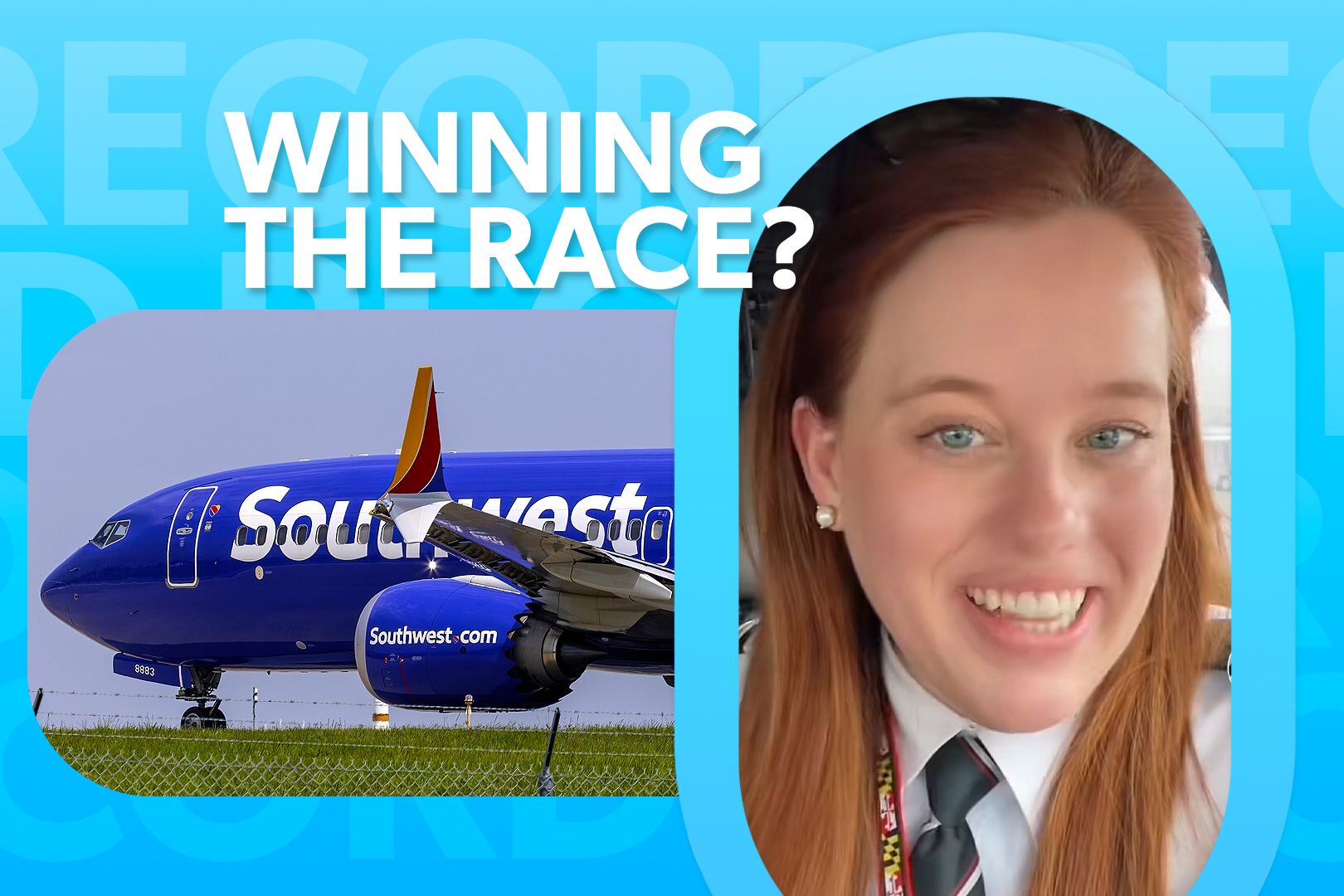Southwest Airlines has been recognized by avgeeks and avid travelers alike for its seemingly speedy taxis across airport tarmacs. However, a viral TikTok Southwest pilot sets the record straight on how fast pilots taxi. Morgan Smith is an Orlando-based Boeing 737 first officer and has reported that Southwest's policy regarding taxi speed states that pilots must taxi at a speed of 20 to 30 knots, which equals roughly 23 to 35 miles per hour.
The taxi speed policy aligns with all other major US-based air carriers. Smith made it clear that a pilot's taxi speed is a gauge, and even on a global scale, 99% of airlines do not permit their pilots to exceed a taxi speed of over 30 knots. Cirium aviation analytics reports that Southwest's 737s perform an average of three to four shorter stage-length flights daily.

Depending on the trip, Southwest's pilots may spend more time on the ground than a United Airlines crew operating a Boeing 767 wide-body to a long-haul destination. Most Southwest's flights are shorter, offering its passengers more point-to-point service. However, Southwest operated a flight from Phoenix to Honolulu, with a block time of almost seven hours last year .
Taxi time can make or break on-time performance, as faster taxis can compensate for time lost on shorter flights. That said, pilots operating larger aircraft on longer-haul routes are not as concerned about taxiing quickly and will taxi the aircraft well within the standard 20-to-30-knot threshold. Southwest's pilots often operate several quick turns during their work day and have been seen taxiing at what appears to be the 30-knot limit, whereas legacy airline pilots operating on a more generous turn time are not as often seen taxiing right at the limit.
Fast or slow, long or short: There's a reason for it all. Smith, the TikTok star, has been posting videos answering people's aviation questions since the pandemic. She has earned tens of thousands of views on her videos, posting captivating content physically on Southwest aircraft and at many major airports in the US.
It is safe to say that she is the ultimate source of truth regarding Southwest's taxi speeds. Understanding how commercial aircraft taxi Thousands of commercial jets safely taxi across congested airport tarmacs each day. Airport taxiways serve as the pathway to terminals, runways, and maintenance and cargo facilities.
For years, taxiways have been well-labeled and lit to help pilots safely guide their aircraft to its ground destination. Several variables dictate how airline pilots can and should taxi. Aircraft are complex machines with numerous devices to help them advance while traveling on the ground.
A highly skilled flight-deck crew is not sequestered into just one aircraft mechanism, as the elements and other aircraft traffic affect the delicate art of the taxi. The list below explores the main taxi tools pilots can utilize when traversing an airport's surface. Nosewheel steering Taxi speeds mostly rely on an aircraft's captain, as the tiller on a narrowbody aircraft is traditionally found on the left side of the flight deck.
The captain is assigned to the coveted left seat, whereas the first officer is assigned to the right seat. The tiller is a flight deck instrument that controls the nosewheel's direction. In addition to steering the nose of the aircraft, the tiller enables smoother and more precise steering.
A tiller is extremely helpful when the crew has to perform a tight or quick maneuver. Widebody aircraft often have two tillers, one on each side of the flight deck. Flightradar24 blogger Chris Lomas further explained how the tiller works on aircraft.
"The tiller is essentially a taxiway tool, and many airlines’ standard operating procedures (SOPs) forbid the use of the tiller for steering above a specified speed, typically between 20 and 30 knots. Some aircraft only have one tiller, meaning only one pilot can operate it." The rudder A rudder is a moveable control surface located on the trailing edge of most aircraft's vertical stabilizer, also known as the tail.
It controls an aircraft's ability to turn left or right. When the rudder moves, the relative airflow hitting the aircraft's tail creates a force that pushes the tail in the opposite direction, causing the nose to move in the desired direction. The experience of manipulating a rudder can be compared to using your car's steering wheel.
When you want to turn left, turn your steering wheel to the left. The same principle can be applied when turning an airplane. Thrust Thurst is typically associated with powering a jetliner during its take-off rotation.
However, thrust can also be used when taxiing . Since engine thrust is an aircraft's primary propulsion system, applying thrust can help move the aircraft forward or even backward. However, the use of reverse thrust (when taxiing) isn't a common practice.
Pilots then manipulate the throttle to apply the desired amount of thrust for aircraft equipped with jet or turboprop engines. Pilots typically use a small amount of thrust to conserve fuel and that maximum power is not needed to taxi an aircraft. Most airlines prefer their pilots to utilize only one engine when taxiing to conserve fuel.
Single-engine taxiing does have its limitations, as certain operational conditions can warrant the use of both engines. The single-engine taxi procedure further promotes a safety culture between the ramp team and the pilots. Only one engine is operational as the aircraft approaches its gate, and the risk of inadvertent engine ingestion is much lower when only one engine is running when the aircraft comes to a complete stop.
How do pilots know where they're going when taxiing? Pilots are highly trained and skilled at flying commercial aircraft. Taxiing an aircraft is just as important as flying one. They rely on four key sources to navigate a busy airfield: Air Traffic Control: ATC provides pilots with clearance instruction Airport layout diagrams: A pilot's EFB is equipped with detailed airport maps Taxiway signage: Taxiways and runways are marked with letter and number designators Radar: Surface movement radar tracks an aircraft's ground movement in tandem with aircraft surveillance equipment Narrowbody versus widebody Have you ever noticed that widebody jets appear to taxi slower than narrowbody jets? Chances are, the widebody jet is taxiing slower.
Due to several factors, widebody jets must taxi slightly slower than narrowbody jets. A widebody's sheer size and weight make it harder to handle, as it has greater inertia than a narrow body. Since widebody jets feature a greater wingspan, pilots must be especially aware of smaller taxiways and gate areas that could challenge a widebody's impressive wing span.
Narrowbody aircraft are much more versatile, as they can fit in most airport gate areas. Longer-range narrowbody aircraft have become increasingly more popular as they are much easier to handle at airports near and far. Tires are also a major factor in aircraft taxi speeds.
Widebody aircraft have much larger tires than narrowbody aircraft. At major global airports like John F. Kennedy International Airport (JFK), taxi times can be long during international rush hour, and many internationally departing widebody aircraft are required to taxi for longer.
Longer, higher-speed taxis can increase heat generation, causing a jet's tire to overheat. A widebody aircraft is most likely carrying more passengers and cargo than its narrowbody siblings, so pilots must ensure that they put as little stress on the tires as possible. Taxi speed depends on the airport, the taxiways, the weather, and the pilot.
Southwest and its legendary quick turn From its inception, Southwest has been built on low costs and efficiency. It was originally founded in 1966 by Herbert Kelleher and Rollin King as "Air Southwest." Southwest discovered early on that it could operate much more cost-effectively than its competitors by utilizing a single fleet type.
The carrier has flown the 737 for over 50 years and has no plans to change its fleet. Since 1971 (except the years 1978 to 1985), Southwest has only operated the 737, and the chart below displays its commitment to the popular jet. 737 Variant: Number of aircraft in service: Historic: Average age: 737-200 x 62 x 737-300 x 195 x 737-500 x 25 x 737-700 327 170 19.
1 years 737-800 199 4 9.6 years 737 MAX 8 254 x 3.2 years A single fleet type allows streamlined efficiencies when "turning" an aircraft.
Since Southwest's entire front-line workforce only has to handle a single aircraft type, ground personnel can quickly load and unload bags and prepare the aircraft for its next departure. The US industry average turnaround time is roughly 45 minutes. Southwest reports that it aims to turn its aircraft in 45 minutes.
ULCC and LCC carriers aim for a shorter turn time as their aircraft must have a higher utilization rate to keep the company's cost low. The airline reportedly used to turn its planes in just 10 minutes when they began operations, according to its blog about its then-Vice President of Terminal Operations Bill Franklin. "So what if most airlines took an hour to turn a plane? Southwest wasn’t most airlines.
Franklin just needed to convince everyone the short turnaround was possible—starting with his Team on the ground. It was a do-or-die moment for Southwest, and Franklin made sure everyone knew the Company’s survival was at stake. “We’re going to do 10-minute turns with this airplane,” he said.
“If you can’t do a 10-minute turn, you’re going to get fired and we’ll bring somebody else in. And if he can’t do a 10-minute turn, we’ll fire him, too. And we’ll just keep firing until we can find someone who can do it.
” An efficient turn-time allows Southwest to keep its aircraft flying more flights for a longer period, driving its revenue earnings potential. The major cornerstones of the carrier's business model are high-volume and point-to-point routing. Southwest's aircraft have been nationally recognized for their quick taxis.
Aircraft often have to turn around as quickly as possible so they can fly as many flights as possible throughout the day and, most recently, at night . This reason alone could explain why the airline appears to have the fastest taxiing aircraft..
Top

Southwest Airlines Pilot Sets The Record Straight On How Fast Planes Taxi

Taxi speeds are regulated by all commercial airlines.









